Abstract
Maturity is a crucial indicator in assessing the quality of tomatoes, and it is closely related to lycopene content. Using hyperspectral imaging, this study aimed to monitor tomato maturity and predict its lycopene content at different maturity stages. Standard normal variable (SNV) transformation was applied to preprocess the hyperspectral data. Then, using competitive adaptive reweighted sampling (CARS), the characteristic wavelengths were selected to simplify the calibration models. Based on the full and characteristic wavelengths, a support vector classifier (SVC) model was developed to determine tomato maturity qualitatively. The results demonstrated that the classification accuracy using the characteristic wavelength led to the obtention of better results with an accuracy of 95.83%. In addition, the support vector regression (SVR) and partial least squares regression (PLSR) models were utilized to predict lycopene content. With a coefficient of determination for prediction (R2P) of 0.9652 and a root mean square error for prediction (RMSEP) of 0.0166 mg/kg, the SVR model exhibited the best quantitative prediction capacity based on the characteristic wavelengths. Following this, a visual distribution map was created to evaluate the lycopene content in tomato fruit intuitively. The results demonstrated the viability of hyperspectral imaging for detecting tomato maturity and quantitatively predicting the lycopene content during storage.
1. Introduction
Tomatoes have become one of the world’s most important fruits [1]. China is currently the world’s largest producer and exporter of tomatoes. Tomatoes significantly impact the development of China’s agricultural trade economy. They are extremely popular with consumers due to their sweet and sour taste and rich nutritional value [2]. In addition, they are abundant in vitamins and minerals [3,4]. Lycopene in tomatoes has been receiving a lot of attention lately, because it can capture free radicals in the body, thereby protecting cells, and has various functions, such as preventing various cancers and reducing atherosclerosis incidence [5,6]. Tomatoes are generally harvested at the early maturity stage to increase storage life [7,8]. Green ripe tomatoes picked in the same batch do not ripen at a synchronized pace during storage, and some fruits may ripen first and become unsuitable for long-term storage. Nonetheless, due to tomatoes’ characteristics, those with a high degree of maturity not only have poor storage performance but also induce the surrounding fruit to enter the stage of respiratory hopping, thereby diminishing their overall quality [9,10]. Therefore, in the tomato storage process, it is of great practical importance to rapidly identify tomato ripeness, which not only can guide people to consume tomatoes of high maturity and good quality, but also can promptly remove tomatoes unsuitable for storage.
Artificial sensory evaluation and physical and chemical analysis are the most common methods used for determining the quality of tomatoes. Among them, sensory evaluation has strict requirements for assessing personnel and the environment, and assessors can easily influence the evaluation results [11]. On the other hand, physical and chemical tests rely on expensive and sophisticated instruments and lengthy procedures. Moreover, they may harm the samples. Therefore, it is necessary to develop a method that is objective, intelligent, and nondestructive for determining the quality of tomatoes, which will be useful for producers, processors and distributors to determine the quality of tomatoes. Physical and chemical indicators of tomato quality include hardness, and lycopene, vitamin C, soluble solid, and titratable acid content, among others. Among these, lycopene content is a crucial indicator frequently employed to characterize the quality of tomatoes.
Electronic nose [12,13], near-infrared spectroscopy (NIRS) [14,15], and machine vision [16,17] are notable intelligent detection technologies that are used to assess tomato quality. Based on the volatile odor substances and colors of samples at different maturation stages, they detect maturity. However, these techniques do not provide the most accurate physical and chemical index predictions. NIRS is a nondestructive tool for analyzing the quality of multiple foods’ raw material components [18]. However, NIRS spectral assessments of relatively small point source measurements do not include spatial information, which is crucial for many food inspection applications [19].
Hyperspectral imaging technology is a technical fusion technology of spectral analysis technology and image processing technology. It was created in the 1980s. It combines traditional two-dimensional imaging and spectroscopy technology with ultra-multi-band high spectral resolution and map uniformity [20]. Compared with single NIRS or machine vision technology, it provides more comprehensive information. It has been researched in fruit quality testing and other tests. It can simultaneously collect fruits’ appearance and spectral information to evaluate their internal and external quality. Rajkumar et al. [21] used hyperspectral imaging for the prediction of the total soluble solids, moisture content and firmness of banana fruits at three different temperatures. The results showed that the best effect was obtained using the multiple linear regression method with coefficients of determination of 0.85, 0.87, and 0.91, respectively. Sun et al. [22] used a near-infrared hyperspectral imaging system to predict the sweetness and hardness of melons. Among the three prediction models, the PLSR model was the best for prediction using either the full spectrum or the most important spectrum. Li et al. [23] studied cherries at different stages using NIR hyperspectral imaging technology. GA-MLR models obtained the best performance in predicting both the soluble solids content and PH. The R2p for soluble solids content was 0.863, and RMSEP was 1.210%. The R2p for PH was 0.819, and RMSEP was 0.057%. The linear discriminant analysis method was used to classify the cherry maturity stage, and the correct classification rate was 96.4%.
Due to variations in tomato maturity, their physical and chemical properties change, as do their light reflection and projection capabilities. Therefore, based on prior studies, hyperspectral image technology was used to distinguish tomato maturity and quantitatively predict the corresponding indicators qualitatively.
Hyperspectral imaging’s ability to provide spatial information of attributes makes it most ideal for this study. In this paper, the nondestructive detection technology of hyperspectral imaging is used to qualitatively identify tomato maturity during storage and quantitatively predict the lycopene content of tomatoes. It can serve as a guide for determining the optimal tomato consumption period.
2. Materials and Methods
2.1. Tomato Samples
Tomatoes of the “Jinpeng” variety were purchased from a greenhouse in Zhenjiang, China. All tomatoes were harvested by hand when they were still at the green maturity stage. Overall, 144 tomatoes weighing 180 ± 20 g were selected. After being numbered, the tomatoes were stored in a constant-temperature humidity room at approximately 20 °C and 85% relative humidity. Following the United States Department of Agriculture’s grading standard for fresh tomatoes, samples are classified into different stages based on their appearance description in Table 1 [24].

Table 1.
The appearance description of tomatoes at different maturity stages.
2.2. Hyperspectral Image System and Data Acquisition
The hyperspectral imaging system used in this study consisted primarily of a spectrometer (ImSpector V10E, Spectral Imaging Co., Ltd., Oulu, Finland), a CCD camera with a detector size of 1024 × 478 pixels, a lens (OLE23, Specim Ltd., Oulu, Finland), a 390 nm UV light source (UBerLEDTM 50, Illumination Technology, Inc., New York, NY, USA), and a stepper motor and a computer [25]. Before acquiring hyperspectral images, the instrument had to be preheated for 30 min. Then, the end of the tomato sample’s pedicle was placed horizontally on the platform, and the lens distance was set to 400 mm. The camera exposure time was 10.5 ms, and the translation platform’s speed was 5.2134 mm/s. One hundred forty-four hyperspectral images were obtained in total. The collected spectral range was 480.80–1002.20 nm, with a total of 411 bands.
2.3. Spectra Extraction
Raw hyperspectral images, Iraw, were calibrated using the following expression to eliminate the effects of irregular light source intensities and the dark current.
where Ical indicates the calibrated image, Iraw means the raw image, Idark represents the dark reference image, and Iwhite denotes the white reference image.
Ical = (Iraw − Idark)/(Iwhite − Idark)
After calibrating the hyperspectral image, threshold segmentation was applied to determine the region of interest (ROI) and remove background information. Figure 1 demonstrates the extraction procedures for spectral data. First, the mask image was generated using a gray image at a high-fluorescence-intensity band (723.36 nm) and a threshold of 0.25. The ROI was then constructed using the mask to eliminate background information from the hyperspectral image. Next, the mean spectral value of all pixels within the ROI was calculated to represent the spectral data for each tomato sample [26]. Since the hyperspectral data of samples before 480 nm were greatly affected by hardware noise, it was impossible to eliminate the wavelengths with noise. The final spectral data were obtained for 411 wavelengths, with a wavelength range of 480.80–1002.20 nm.
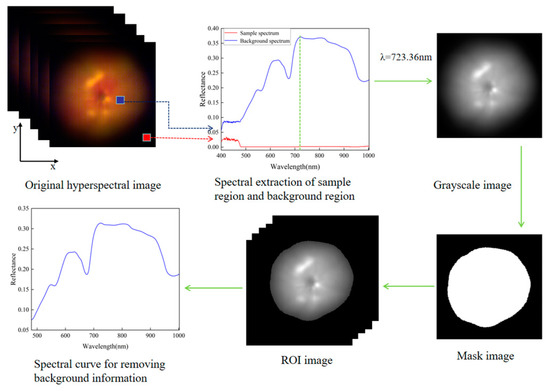
Figure 1.
Specific steps of spectral extraction.
2.4. Determination of the Lycopene Content
The lycopene content was determined using the agricultural standard NY/T 1651–2008 “Determination of lycopene in vegetables and products-HPLC”. The HPLC conditions were as follows. The detection wavelengths were 472 nm. The column was made of C18 stainless steel and measured 250 nm in length, 4.6 mm in diameter, and 5 mm in particle size. The mobile phase was a 4:15:1 volume mixture of methanol, acetonitrile, and dichloromethane; all three reagents were chromatographically pure. The flow rate was 1.0 mL and the injection volume was 10 µL.
We first constructed a standard curve from lycopene standards to determine the lycopene content of tomato samples. The preparation of the lycopene standard solution consisted primarily of the following steps. Briefly, 10 mg of lycopene standard product with a purity of ≥98% was weighed, and chromatographically pure dichloromethane was used as the solvent to prepare a lycopene standard product with a concentration of 100 mg/L. Subsequently, gradient dilution with dichloromethane was used to prepare lycopene standard solutions with 1, 5, 10, 20, and 30 mg/L concentrations, A 0.45 μm microporous membrane filtered the standard solution before it was transferred to a brown liquid phase vial. The area of the peak was then determined using a high-performance liquid chromatograph.
2.5. Data Analysis
2.5.1. Data Preprocessing
Spectral pre-processing is an important step in establishing a spectral detection algorithm in order to reduce errors due to external factors and random noise, and baseline changes [27]. Additionally, influencing the spectrum are factors such as the scattering of the object’s surface and the alteration of the optical path. For this reason, SNV transformation was chosen and implemented to preprocess the black-and-white calibrated hyperspectral data.
SNV is mainly used to correct each spectrum for errors due to particle scattering, using the principle that the absorbance values at each wavelength of the spectrum satisfy a certain distribution. The SNV transform is corrected by subtracting the mean value of the spectrum from the original spectrum and dividing it by the standard deviation of the original spectrum. The formula is shown as follows:
where means the spectrum corrected by SNV, indicates the original spectrum, represents the mean value of the spectrum, and N denotes the number of wavelengths.
2.5.2. Feature Selection
Since hyperspectral data consist of hundreds of continuous wavelengths, the data volume is large, and the adjacent wavelengths are highly correlated and redundant [28]. Therefore, feature selection is essential for simplifying the model and improving detection efficiency. CARS is a feature selection method based on Monte Carlo sampling (MCS) and PLSR regression coefficients that selects the optimal subset of wavelengths by mimicking the “survival of the fittest” principle [29]. In this study, CARS was used to select features from full spectra to develop a simple and efficient prediction model.
In the CARS, each variable is a single individual, and in each iteration, the highly adaptive individuals are retained and the weakly adaptive individuals are eliminated. The process of eliminating individuals relies on the exponential decreasing function (EDF) and adaptive reweighted sampling (ARS), which retains variables with large absolute values of the regression coefficients and excludes those with small absolute values of the regression coefficients in each modeling process. Using the interactive validation method, the variables in the subset with the minimum RMSECV are selected as the feature variables. The main steps of the CARS are as follows.
Firstly, the calibration set and prediction set are determined from the sample set in a certain proportion based on the MCS method. The PLSR model is built, and the regression coefficients corresponding to each variable are calculated.
Secondly, the EDF is used to delete the variables with small absolute values of regression coefficients; on the basis of this operation, the variables are further eliminated with the help of ARS, and the above steps are repeated to form an iterative process.
Finally, the RMSECV of the selected subset of variables is calculated, and the variables contained in the subset with the minimum RMSECV are taken as the selected feature variables.
2.6. Model Establishment and Evaluation
SVM is a method based on statistical principles and follows the principle of structural risk minimization. It achieves the purpose of pattern recognition through the supervised learning of samples. SVM not only has a simple computation and a short training time, but also has good generalization performance and robustness [30]. SVM can be used for both data classification and regression analysis. Using a nonlinear model, a support vector classifier (SVC) can handle high-dimensional data. In addition, its accuracy is superior to that of other machine learning algorithms [31].
The basic idea of the SVR algorithm is to create an optimal hyperplane by using the training sample, and minimize the total deviation of the sample points from the hyperplane by approximating the samples to the hyperplane. The kernel function is used to achieve nonlinear mapping from the input space to the high-dimensional space, so as to realize linear regression and improve the learning effect [32]. SVM uses different kernel functions and obtains different support vector machine algorithms. This paper optimizes the parameters c and g using grid optimization algorithm search methods and five-fold cross-validation methods.
PLSR is a traditional multivariate linear statistical analysis method that maps multidimensional data onto orthogonal latent variable (LV) factors. The minimum predicted residual error sum of squares was used to determine the optimal number of LVs [33].
SVC was used to classify the tomatoes. Utilizing PLSR and SVR, a correlation between hyperspectral data and lycopene content was established. The accuracy and precision of the model were measured using statistical measures such as the coefficient of determination for calibration (R2C), R2P, root mean squared errors of cross-validation (RMSECV) and RMSEP. MATLAB 2020a was used to perform the data analysis, with Windows 11 as the operating system.
3. Results and Discussion
3.1. Lycopene Analysis
Lycopene content is a relatively intuitive indicator of tomato maturity. Due to variations in lycopene content, the color of a tomato also varies. Figure 2 depicts the mean and standard deviation of lycopene content during storage. It is evident from the figure that the lycopene content of tomato samples increased from 1.97 mg/kg to 111.82 mg/kg. Almost no lycopene was present during the green stage, and lycopene synthesis did not begin until the breaker stage. In subsequent stages, the lycopene content also increased.
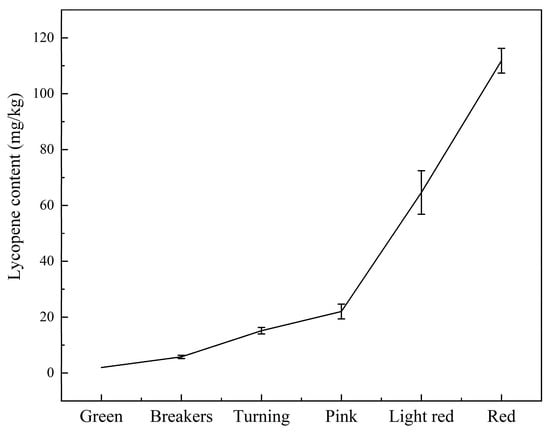
Figure 2.
Lycopene contents of tomatoes at different maturity stages.
3.2. Spectral Feature Analysis
Figure 3 depicts the average spectral curves in the range 480.80–1002.20 nm for tomatoes at various maturity stages. In the range 480.80–700.35 nm, the trends of the spectral reflectance were different, whereas they were similar in the range 723.36–969.92 nm. The significant difference in the visible range was likely caused by the color changes of tomatoes at various maturity stages [34]. The wave trough near 670 nm was associated with chlorophyll absorption in tomatoes. The chlorophyll content of ripening tomatoes decreased or disappeared completely. Due to the second overtone of the stretching of the O-H bond, there was a noticeable absorption peak at 969.72 nm [35].
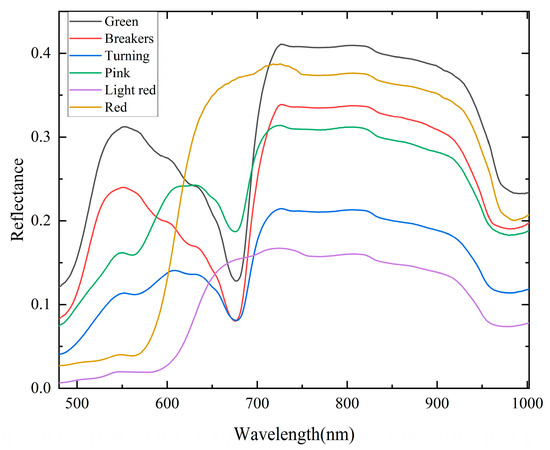
Figure 3.
Average spectral curves of tomatoes at different maturity stages.
3.3. Selection of Characteristic Wavelengths
Selecting characteristic wavelengths can increase the operating speed and eliminate redundant information [36]. CARS was used to select the characteristic wavelengths. The number of MCS was set to 50 and five-fold cross-validation was utilized. The final selected wavelengths were determined by analyzing the values of the PLSR model. Figure 4 depicts the characteristic wavelength selection process of CARS. Figure 4a depicts a trend chart for wavelength number, reflecting the two different stages of effective wavelength selection: fast selection and refined selection. At the beginning, the number of selected wavelengths decreases sharply when the variables are forced out by EDF, and then the number of wavelengths becomes relatively stable. Figure 4b displays the RMSECV trend. During the first 29 sampling runs, the RMSECV of the PLSR model decreases slightly with the increase in the sampling times due to the gradual elimination of unimportant wavelengths. After the 29th sampling run, the RMSECV starts to become larger. Thus, the 29th sampling run represents the junction of underfitting and overfitting, and the subset of optimal variables. Figure 4c is a trend diagram of the wavelength regression coefficient, and the blue line indicates that the selected wavelength has the minimum RMSECV for the PLSR model when the optimal sampling number is 29. Finally, 20 wavelengths with distinct characteristics were chosen (518.57, 530.85, 555.54, 574.17, 595.39, 659.64, 662.18, 665.99, 671.07, 672.34, 686.33, 722.08, 736.17, 751.57, 782.45, 821.15, 898.76, 915.59, 935.00, and 984.13 nm).

Figure 4.
Selection of characteristic wavelengths by CARS. (a) The variation trend for wavelength number with the increase in sampling runs; (b) the variation trend of RMSECV; (c) the variation trend of the wavelength regression coefficient during variable selection. blue * indicates the optimal sampling number.
3.4. Classification Model
Randomly dividing 144 tomato samples into calibration sets and prediction sets with a ratio of 2:1, a total of 144 tomato samples were categorized. The tomato identification SVC models were established using the full (FULL) and characteristic wavelengths. Figure 5 depicts the confusion matrices of the prediction set with two different input data sets of SVC, while Table 2 displays the results of optimal parameters and the performance evaluation for SVC models based on FULL and characteristic spectral data.
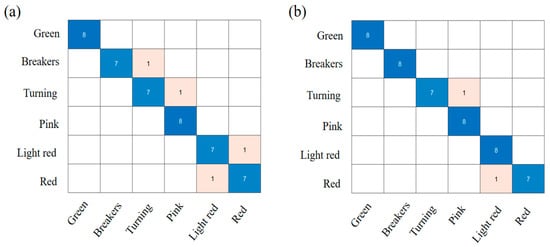
Figure 5.
The confusion matrices of the prediction set with two different input data sets of SVC: (a) FULL-SVC and (b) CARS-SVC.

Table 2.
The results of performance evaluation for SVC models based on FULL and characteristic spectral data.
As shown in Figure 5a, the prediction accuracy rate for the FULL-SVC model was 91.67%, and the precision, recall and F1-score were 91.90%, 91.67% and 91.79%. It was easy to distinguish between green and pink stages, whereas other stages were misclassified as adjacent grades. This may have been because the color distribution on the surface of the fruit was less variable on tomatoes of adjacent ripeness grades. Figure 5b showed the confusion matrices of the prediction set for the CARS-SVC model. The CARS-SVC model achieved a better performance of 95.83% accuracy rates, 96.30% precision, 95.83% recall, and a 96.07% F1-score. The classification accuracy of the pink and light red stages was higher than that of the breaker and turning stages, which is consistent with previous studies [37]. It was evident that the performance using the characteristic wavelength was higher than that using full wavelengths and that the number of feature variables was significantly lower for characteristic wavelengths than for that for full wavelengths. For modeling, it was necessary to extract characteristic wavelengths from full spectra.
Cho et al. [38] developed a classification model for tomato maturity involving six stages using snapshot-type hyperspectral imaging and SVC. At the laboratory level, the highest classification accuracy and F1-score were 79% and 88%, respectively, while at the field level, classification accuracy and F1-scores were 75% and 86%, respectively. The main reasons for the low classification accuracy were that the tomatoes were grown in different periods and were affected by various test environments, such as camera angle, external light intensity, and so on. Nevertheless, hyperspectral imaging has the potential to be used as a useful tool to classify tomato maturity.
3.5. Quantitative Model
In total, 144 tomato samples were quantitatively analyzed. Briefly, 144 tomato samples were randomly divided into calibration sets and prediction sets with a ratio of 2:1. The SVR and PLS models were developed to quantitatively analyze tomato lycopene content based on the full and characteristic wavelengths. Choosing the appropriate parameters, c and g, is crucial for SVR to avoid over-fitting and improve modeling accuracy. The grid optimization algorithm search methods and five-fold cross-validation methods were used to optimize the parameters c and g. The five-fold cross-validation method was used to determine the optimal number of LVs. Table 3 provides the results of SVR and PLSR for predicting the tomato lycopene content in tomatoes. Models based on characteristic wavelengths performed significantly better than those based on complete wavelengths. In addition, it was observed that the SVR model exhibited excellent quantitative prediction capacity, regardless of whether it was based on the full wavelengths or the characteristic wavelengths, indicating that SVR possessed advantages in nonlinear small sample prediction. When the optimization parameters were c =64 and g = 0.0442, the CARS-SVR model yielded R2C = 0.9826, RMSECV = 0.0079 mg/kg, R2P = 0.9652, and RMSEP = 0.0166 mg/kg. Figure 6 illustrates the performance of the SVR and PLSR models by depicting the measured and predicted lycopene contents. A strong correlation can be observed between the predicted and measured values.

Table 3.
The results of SVR and PLSR models for predicting the tomato lycopene content in tomatoes.
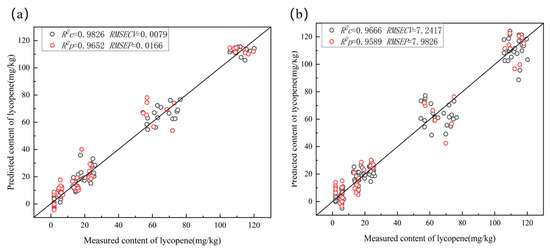
Figure 6.
Predicted and measured lycopene content values for (a) SVR and (b) PLSR models based on characteristic wavelengths.
The results show that modeling with fewer wavelengths obtained based on feature selection does not only improve the predictive performance of the model, but also simplifies the model and improves its robustness. The established models, particularly the CARS-SVR model, can effectively detect the lycopene content of tomatoes. Rahman et al. [1] used hyperspectral imaging for the prediction of moisture content, pH and soluble solid content in intact tomatoes. The results showed that the best effect was obtained using PLSR with the correlation coefficients of 0.81, 0.69, and 0.74. These studies demonstrate that hyperspectral imaging has the potential to predict the chemical compositions in tomatoes nondestructively, which provides important guidance for determining the picking period, quality grading, transportation and storage of tomato fruits.
3.6. Visualization of the Lycopene Content
To visualize the lycopene content of the tomatoes throughout their entire maturity stages, the CARS-SVR prediction model was applied and the calibration results of the multivariate analysis were transferred to each pixel of the hyperspectral image. Figure 7 depicts the visualization of the lycopene content. According to the color bar on the figure’s right side, blue indicated low content, red indicated high content, and the transition from blue to red indicated that the lycopene content of tomatoes gradually increased with maturity. The change in pseudocolors in Figure 2 corresponded to an increase in the lycopene content. When the lycopene content reached about 110 mg/kg, the whole tomato was close to red. As can be seen in Figure 7, the color of each part of the tomato was not regular, indicating that the distribution of the lycopene content in tomatoes was uneven.
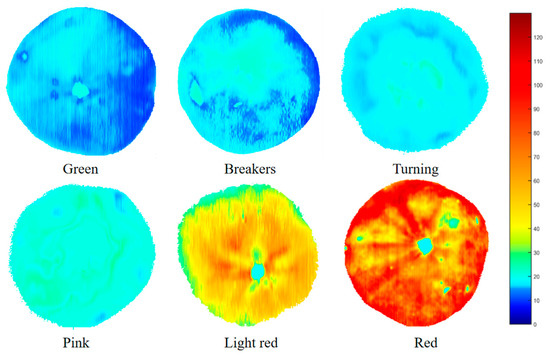
Figure 7.
Visualization of lycopene content in tomatoes at green, breaker, turning, pink, light red and red stages.
4. Conclusions
In this paper, hyperspectral imaging was applied to classify tomato maturity into six stages and to predict the lycopene content of tomatoes. SVC classification models were established using the full and characteristic wavelengths. The results showed that SVC classification models were established using the full and characteristic wavelengths. The results showed that the prediction set’s accuracy rate for CARS-SVC models was higher than that for FULL-SVC models, at 95.83%.
CARS established the SVR and PLSR models of the lycopene content based on the full and characteristic wavelengths. With R2P = 0.9652 and RMSEP = 0.0166 mg/kg, the models created by CARS-SVR yielded the best results regarding their effects and stability.
Following this, pseudocolors were generated to visualize the lycopene content of tomatoes. The result indicated that hyperspectral technology could detect tomato maturity during storage and quantitatively predict lycopene content. As a form of nondestructive testing technology, hyperspectral imaging technology can promote the development of intelligent tomato quality detection. In the study, only one main chemical component was predicted using hyperspectral imaging, and further research is needed to obtain more comprehensive information to comprehensively evaluate tomato quality.
Author Contributions
Conceptualization, C.D.; data curation, C.D. and X.Z.; formal analysis, X.Z.; funding acquisition, C.D. and J.S. (Jun Sun); investigation, C.D.; methodology, X.H.; project administration, C.D.; resources, J.S. (Jun Sun) and X.H.; software, X.T.; supervision, W.W.; validation, C.D.; project administration, C.D.; visualization, C.D.; writing—original draft, C.D.; writing—review and editing, J.S. (Jingtao Sun) and Y.L. All authors have read and agreed to the published version of the manuscript.
Funding
This work was sponsored by Jiangsu Province and Education Ministry Co-Sponsored Synergistic Innovation Center of Modern Agricultural Equipment (XTCX2016) and National Natural Science funds projects (31971788), a project funded by the Priority Academic Program Development of Jiangsu Higher Education Institutions (PAPD-2018-87).
Data Availability Statement
Data are contained within the article.
Conflicts of Interest
The authors declare no conflict of interest.
References
- Rahman, A.; Kandpal, L.M.; Lohumi, S.; Kim, M.S.; Lee, H.; Mo, C.; Cho, B.-K. Nondestructive estimation of moisture content, pH and soluble solid contents in intact tomatoes using hyperspectral imaging. Appl. Sci. 2017, 7, 109. [Google Scholar] [CrossRef]
- Salehi, B.; Sharifi-Rad, R.; Sharopov, F.; Namiesnik, J.; Roointan, A.; Kamle, M.; Kumar, P.; Martins, N.; Sharifi-Rad, J. Beneficial effects and potential risks of tomato consumption for human health: An overview. Nutrition 2019, 62, 201–208. [Google Scholar] [CrossRef] [PubMed]
- Abdelhamid, M.A.; Sudnik, Y.; Alshinayyin, H.J.; Shaaban, F. Non-destructive method for monitoring tomato ripening based on chlorophyll fluorescence induction. J. Agric. Eng. 2021, 52, 1098. [Google Scholar] [CrossRef]
- Melfi, M.T.; Nardiello, D.; Cicco, N.; Candido, V.; Centonze, D. Simultaneous determination of water- and fat-soluble vitamins, lycopene and beta-carotene in tomato samples and pharmaceutical formulations: Double injection single run by reverse-phase liquid chromatography with UV detection. J. Food Compos. Anal. 2018, 70, 9–17. [Google Scholar] [CrossRef]
- Engelhard, Y.N.; Gazer, B.; Paran, E. Natural antioxidants from tomato extract reduce blood pressure in patients with grade-1 hypertension: A double-blind, placebo-controlled pilot study. Am. Heart J. 2006, 151, 100.e1–100.e6. [Google Scholar] [CrossRef]
- Omoni, A.O.; Aluko, R.E. The anti-carcinogenic and antiatherogenic effects of lycopene: A review. Trends Food Sci. Technol. 2005, 16, 344–350. [Google Scholar] [CrossRef]
- Arah, I.K.; Amaglo, H.; Kumah, E.K.; Ofori, H. Preharvest and postharvest factors affecting the quality and shelf life of harvested tomatoes: A mini review. Int. J. Agron. 2015, 2015, 478041. [Google Scholar] [CrossRef]
- Tolesa, G.N.; Workneh, T.S. Influence of storage environment, maturity stage and pre-storage disinfection treatments on tomato fruit quality during winter in KwaZulu-Natal. J. Food Sci. Technol. 2017, 54, 3230–3242. [Google Scholar] [CrossRef]
- Seo, D.; Cho, B.H.; Kim, K.C. Development of monitoring robot system for tomato fruits in hydroponic greenhouses. Agronomy 2021, 11, 2211. [Google Scholar] [CrossRef]
- Abebe, Z.; Tola, Y.B.; Mohammed, A. Effects of edible coating materials and stages of maturity at harvest on storage life and quality of tomato (Lycopersicon esculentum mill.) fruits. Afr. J. Agric. Res. 2017, 12, 550–565. [Google Scholar] [CrossRef]
- Huang, X.; Pan, S.; Sun, Z.; Ye, W.; Aheto, J.H. Evaluating quality of tomato during storage using fusion information of computer vision and electronic nose. J. Food Process Eng. 2018, 41, e12832. [Google Scholar] [CrossRef]
- Gómez, A.H.; Hu, G.; Wang, J.; Pereira, A.G. Evaluation of tomato maturity by electronic nose. Comput. Electron. Agric. 2006, 54, 44–52. [Google Scholar] [CrossRef]
- Messina, V.; Domínguez, P.G.; Sancho, A.M.; Walsöe de Reca, N.; Carrari, F.; Grigioni, G. Tomato Quality during Short-Term Storage Assessed by Colour and Electronic Nose. Int. J. Electrochem. 2012, 2012, 687429. [Google Scholar] [CrossRef]
- Clément, A.; Dorais, M.; Vernon, M. Nondestructive Measurement of Fresh Tomato Lycopene Content and Other Physicochemical Characteristics Using Visible–NIR Spectroscopy. J. Agric. Food Chem. 2008, 56, 9813–9818. [Google Scholar] [CrossRef]
- Huang, Y.; Dong, W.; Chen, Y.; Wang, X.; Luo, W.; Zhan, B.; Liu, X.; Zhang, H. Online detection of soluble solids content and maturity of tomatoes using Vis/NIR full transmittance spectra. Chemom. Intell. Lab. Syst. 2021, 210, 104243. [Google Scholar] [CrossRef]
- Wan, P.; Toudeshki, A.; Tan, H.; Ehsani, R. A methodology for fresh tomato maturity detection using computer vision. Comput. Electron. Agric. 2018, 146, 43–50. [Google Scholar] [CrossRef]
- Arakeri, M.P.; Lakshmana. Computer Vision Based Fruit Grading System for Quality Evaluation of Tomato in Agriculture industry. Procedia Comp. Sci. 2016, 79, 426–433. [Google Scholar] [CrossRef]
- Wu, X.; Zhou, H.; Wu, B.; Fu, H. Determination of apple varieties by near infrared reflectance spectroscopy coupled with improved possibilistic Gath-Geva clustering algorithm. J. Food Process. Preserv. 2020, 44, e14561. [Google Scholar] [CrossRef]
- Ariana, D.P.; Lu, R.; Guyer, D.E. Near-infrared hyperspectral reflectance imaging for detection of bruises on pickling cucumbers. Comput. Electron. Agric. 2006, 53, 60–70. [Google Scholar] [CrossRef]
- Qin, J.; Chao, K.; Kim, M.S.; Lu, R.; Burks, T.F. Hyperspectral and multispectral imaging for evaluating food safety and quality. J. Food Eng. 2013, 118, 157–171. [Google Scholar] [CrossRef]
- Rajkumar, P.; Wang, N.; EImasry, G.; Raghavan, G.S.V.; Gariepy, Y. Studies on banana fruit quality and maturity stages using hyperspectral imaging. J. Food Eng. 2012, 108, 194–200. [Google Scholar] [CrossRef]
- Sun, M.; Zhang, D.; Liu, L.; Wang, Z. How to predict the sugariness and hardness of melons: A near-infrared hyperspectral imaging method. Food Chem. 2017, 218, 413–421. [Google Scholar] [CrossRef] [PubMed]
- Li, X.; Wei, Y.; Xu, J.; Feng, X.; Wu, F.; Zhou, R.; Jin, J.; Xu, K.; Yu, X.; He, Y. SSC and pH for sweet assessment and maturity classification of harvested cherry fruit based on NIR hyperspectral imaging technology. Postharvest Biol. Technol. 2018, 143, 112–118. [Google Scholar] [CrossRef]
- Batu, A. Determination of acceptable firmness and colour values of tomatoes. J. Food Eng. 2004, 61, 471–475. [Google Scholar] [CrossRef]
- Zhou, X.; Sun, J.; Tian, Y.; Yao, K.; Xu, M. Detection of heavy metal lead in lettuce leaves based on fluorescence hyperspectral technology combined with deep learning algorithm. Spectrochim. Acta A 2022, 266, 120460. [Google Scholar] [CrossRef]
- Zhang, L.; Wang, Y.; Wei, Y.; An, D. Near-infrared hyperspectral imaging technology combined with deep convolutional generative adversarial network to predict oil content of single maize kernel. Food Chem. 2022, 370, 131047. [Google Scholar] [CrossRef]
- Yao, K.; Sun, J.; Cheng, J.; Xu, M.; Chen, C.; Zhou, X.; Dai, C. Development of Simplified Models for Non-Destructive Hyperspectral Imaging Monitoring of S-ovalbumin Content in Eggs during Storage. Foods 2022, 11, 2024. [Google Scholar] [CrossRef]
- Zhou, X.; Sun, J.; Tian, Y.; Lu, B.; Hang, Y.; Chen, Q. Hyperspectral technique combined with deep learning algorithm for detection of compound heavy metals in lettuce. Food Chem. 2020, 321, 126503. [Google Scholar] [CrossRef]
- Tang, G.; Huang, Y.; Tian, K.; Song, X.; Yan, H.; Hu, J.; Xiong, Y.; Min, S. A new spectral variable selection pattern using competitive adaptive reweighted sampling combined with successive projections algorithm. Analyst 2014, 139, 4894–4902. [Google Scholar] [CrossRef]
- Wang, L.; Xiong, F.; Huang, X.; Aheto, J.H.; Yu, S.; Wang, Y.; Zhang, X.; Ren, Y. Fast monitoring the dynamic change of total acids during apple vinegar fermentation process using a colorimetric ida sensor array. Food chem. 2022, 387, 132867. [Google Scholar] [CrossRef]
- Allouhi, A.; Choab, N.; Hamrani, A.; Saadeddine, S. Machine learning algorithms to assess the thermal behavior of a Moroccan agriculture greenhouse. Clean. Eng. Technol. 2021, 5, 100346. [Google Scholar] [CrossRef]
- Sun, J.; Lu, X.; Mao, H.; Wu, X.; Gao, H. Quantitative determination of rice moisture based on hyperspectral imaging technology and BCC-LS-SVR algorithm. J. Food Process Eng. 2017, 40, e12446. [Google Scholar] [CrossRef]
- Cheng, J.; Sun, J.; Yao, K.; Xu, M.; Dai, C. Multi-task convolutional neural network for simultaneous monitoring of lipid and protein oxidative damage in frozen-thawed pork using hyperspectral imaging. Meat Sci. 2023, 201, 109196. [Google Scholar] [CrossRef]
- Liu, C.; Liu, W.; Chen, W.; Yang, J.; Zheng, L. Feasibility in multispectral imaging for predicting the content of bioactive compounds in intact tomato fruit. Food Chem. 2015, 173, 482–488. [Google Scholar] [CrossRef] [PubMed]
- Shao, Y.; Shi, Y.; Qin, Y.; Xuan, G.; Li, J.; Li, Q.; Yang, F.; Hu, Z. A new quantitative index for the assessment of tomato quality using vis-nir hyperspectral imaging. Food Chem. 2022, 386, 132864. [Google Scholar] [CrossRef]
- Magwaza, L.S.; Opara, U.L.; Nieuwoudt, H.; Cronje, P.J.R.; Saeys, W.; Nicolaï, B. NIR Spectroscopy Applications for Internal and External Quality Analysis of Citrus Fruit—A Review. Food Bioprocess Technol. 2011, 5, 425–444. [Google Scholar] [CrossRef]
- Zhu, Q.; He, C.; Lu, R.; Mendoza, F.; Cen, H. Ripeness evaluation of “Sun Bright” tomato using optical absorption and scattering properties. Postharvest Biol. Technol. 2015, 103, 27–34. [Google Scholar] [CrossRef]
- Cho, B.H.; Kim, Y.H.; Lee, K.B.; Hong, Y.K.; Kim, K.C. Potential of snapshot-type hyperspectral imagery using support vector classifier for the classification of tomatoes maturity. Sensors 2022, 22, 4378. [Google Scholar] [CrossRef]
Disclaimer/Publisher’s Note: The statements, opinions and data contained in all publications are solely those of the individual author(s) and contributor(s) and not of MDPI and/or the editor(s). MDPI and/or the editor(s) disclaim responsibility for any injury to people or property resulting from any ideas, methods, instructions or products referred to in the content. |
© 2023 by the authors. Licensee MDPI, Basel, Switzerland. This article is an open access article distributed under the terms and conditions of the Creative Commons Attribution (CC BY) license (https://creativecommons.org/licenses/by/4.0/).